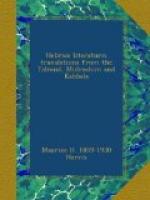The crust of the earth as far as the abyss is a thousand ells, and the abyss under the earth is fifteen thousand. There is an upper and a lower abyss mentioned in Taanith, fol. 25, col. 2. Riddia, the angel who has the command of the waters, and resides between the two abysses, says to the upper, “disperse thy waters,” and to the lower, “let thy waters flow up.”
Many may ask after thy peace, but tell thy secret only to one of a thousand.
Yevamoth, fol. 63, col. 2.
The Rabbis have taught that if the value of stolen property is a thousand, and the thief is only worth, say, five hundred, he is to be sold into slavery twice. But if the reverse, he is not to be sold at all.
Kiddushin, fol. 18, col. 2.
The Behemoth upon a thousand hills (Ps. l. 10), God created them male and female, but had they been allowed to propagate they would have destroyed the whole world. What did He do? He castrated the male and spayed the female, and then preserved them that they might serve for the righteous at the Messianic banquet; as it is said (Job xl. 16), “His strength is in his loins (i.e., the male), and his force in the navel of his belly” (i.e., the female).
Bava Bathra, fol. 74, col. 2.
This provision for the coming Messianic banquet is considered of sufficient importance to be mentioned year after year in the service for the Day of Atonement and also at the Feast of Tabernacles. The remark of D. Levi, that the feast here referred to is to be understood allegorically, involves rather sweeping consequences, as it is open to any one to annihilate many other expectations on the same principle.
The Holy One—blessed be He!—will add to Jerusalem gardens extending to a thousand times their numerical value, which equals one hundred and sixty-nine, etc.
Ibid., fol. 75, col. 2.
“Moreover Manasseh shed innocent blood very much” (2 Kings xxi. 16). Here (in Babylon) it is interpreted to mean that he murdered Isaiah, but in the West (i.e., in Palestine) they say that he made an image of the weight of a thousand men, which was the number he massacred every day (as Rashi says, by the heaviness of its weight).
Sanhedrin, fol. 103, col. 2.
See Josephus, Antiq., Book X. chap, iii., sec. 1, for corroborative evidence. Tradition says that Manasseh caused Isaiah to be sawn asunder with a wooden saw. (See also Yevamoth, fol. 49, col. 2; Sanhedrin, fol. 103, col. 2.)
Nowhere in the Talmud do we find the name of the great image here referred to. What if we christen it the “Juggernaut of the Talmud”? May the tradition not be a prelusion or a reflex of that man-crushing monster? Anyhow, scholars are aware of a community of no inconsiderable extent between the conceptions and legends of the Hindoos and the Rabbis. One notable contrast, however, between this Juggernaut and




